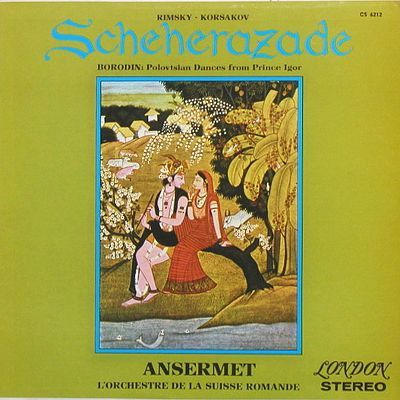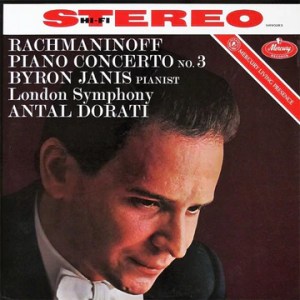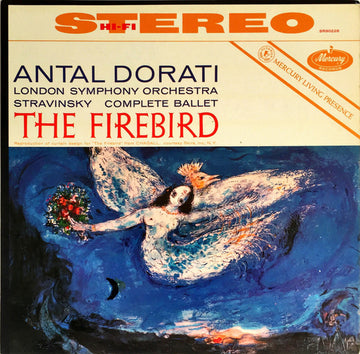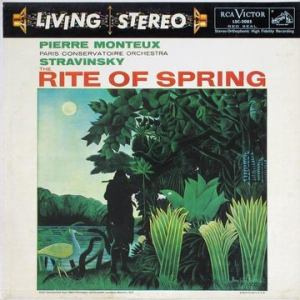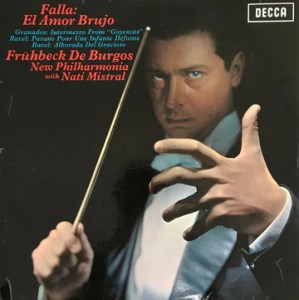More music conducted by Fritz Reiner
More Orchestral Spectaculars
- This Shaded Dog pressing of Reiners’s excellent 1960 recording had the glorious Living Stereo sound we were looking for
- It’s also fairly quiet at Mint Minus Minus, a grade that even our most well-cared-for vintage classical titles have trouble playing at
- There were only three performances with audiophile quality sound in our shootout, and the Shaded Dog pressings not only had the best performances, but the sound that the team of Mohr/Layton managed to achieve was second to none
- In other words, Harry was right to put this on his TAS super disc list – it really is a super disc
- If you know anything about these works, you know that have tons of top and bottom end, and it is the rare pressing that can capture both
- The texture and harmonic overtones of the Living Stereo strings are near perfection – as we listened we became completely immersed in the music on the record, transfixed by the remarkable virtuosity Reiner and the CSO brought to these difficult and demanding works so many years ago
- There are roughly 150 orchestral recordings that we think offer the discriminating audiophile the best combination of superior performances with top quality sound. This record has earned a place on that list.
This shootout has been at least five years in the making, and the case could be made that something like fifteen is closer to the truth. Around 2016 we surveyed the recordings of the work we had on hand — close to a dozen different performances, I think — and found them all wanting, save three: this one (which is still on the TAS list), a Reader’s Digest pressing with Kempe (our second favorite), and a London with Kertesz.
If a particular performance had any distortion or limitation problems in the higher frequencies, it was quickly rejected out of hand. Same with low end whomp and weight. On these works both are crucial.
No other pieces of music of which we are aware have so much going on up high and down low. This narrowed the field of potential Hot Stampers considerably. Great performances by top conductors could not get over these hurdles — high and low — time and time again.
For these reasons, it took us years to find the right recordings. We knew the Reiner would be hard to beat, but we kept trying record after record hoping that we could find one to wrest the crown away from what is widely considered the greatest recording of the works ever made.
We never did find something better. Our best Shaded Dog ended up winning the shootout. The best RCA pressings were doing everything right. There was plenty of top end, with virtually no harmonic distortion, and when I say plenty, I mean the right amount. Not many engineers managed to get all the highs correctly onto the tape, but Lewis Layton nailed it — in 1960!
So many recordings had screechy strings and horns. When the music would get loud — and both the Pines and the Fountains get very loud indeed, assuming the recording will let it — the sound would become unbearably harsh and unpleasant. This is the opposite of what should happen, and it was obvious that those recordings would not make it past the first round.
All three of the finalists could claim enthusiastic performances with powerful energy and top quality orchestral playing. Still, with the best copies going head to head with each other, Reiner had more of all the qualities we were looking for.
How did the famous 1S/1S pressing fare? No idea. I haven’t seen one in twenty years. It may be better than the White Hot copy we are offering here. I certainly would not make the mistake of saying what it sounds like without having played it. If someone has one and wants to send it to me to audition, I would love to give it a spin.
Some recordings we played lacked transparency, as well as the relaxed sense of involvement that eases one’s ability to be tricked into thinking “you (really) are there.”
The famous 1977 Maazel recording for Decca, which was on the TAS List for a long time, suffered from a bad case of multi-miking and the transparency issue mentioned above. What do you expect from 1977?
This is, of course, the knock on the Modern Heavy Vinyl Pressing — where is the transparency? The space? The three-dimensional depth? If your stereo can reproduce these qualities — a big if, since even as recently as twenty years ago mine could not — you should have given up on these opaque and airless frauds years ago.


